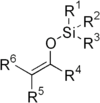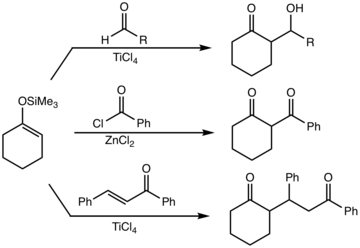Silyl enol ether
Silyl enol ethers in organic chemistry are a class of organic compounds that share a common functional group composed of an enolate bonded through its oxygen end to an organosilicon group. They are important intermediates in organic synthesis.[1][2]

Synthesis
Trimethylsilyl enol ethers can be prepared from ketones in presence of a strong base and trimethylsilyl chloride or a weak base and trimethylsilyl triflate. [3] Alternatively, enolate salts react with silyl electrophiles.
A rather exotic way to generate silyl enol ethers is via the Brook rearrangement of appropriate substrates.[4]
Reactions
C-C Bond formation
Silyl enol ethers react as nucleophiles in many reactions resulting in alkylation, e.g. Mukaiyama aldol addition and Michael reactions.

Halogenation and oxidations
Halogenation of silyl enol ethers gives haloketones.[5]
Acyloins form upon organic oxidation with an electrophilic source of oxygen such as an oxaziridine or mCPBA.[6]
In the Saegusa–Ito oxidation, certain silyl enol ethers are oxidized to enones with palladium(II) acetate.
Ring contraction
Cyclic silyl enol ethers undergo regiocontrolled one-carbon ring contractions.[7][8] These reactions employ electron-deficient sulfonyl azides, which undergo chemoselective, uncatalyzed [3+2] cycloaddition to the silyl enol ether, followed by loss of dinitrogen, and alkyl migration to give ring-contracted products in good yield. These reactions may be directed by substrate stereochemistry, giving rise to stereoselective ring-contracted product formation.
Ketene silyl acetals
Ketene silyl acetals are related compounds formally derived from ketenes and acetals with general structure R-C=C(OSiR3)(OR').
References
- Peter Brownbridge (1983). "Silyl Enol Ethers in Synthesis - Part I". Synthesis: 1–28. doi:10.1055/s-1983-30204.
- Ian Fleming (2007). A Primer on Organosilicon Chemistry. Wiley. doi:10.1002/9780470513323.ch7.
- Nigel D. A. Walshe, Graham B. T. Goodwin, Graham C. Smith, and Frank E. Woodward (1987). "Acetone Trimethylsilyl Enol Ether". Org. Synth. 65: 1. doi:10.15227/orgsyn.065.0001.CS1 maint: uses authors parameter (link)
- Clive, Derrick L. J. & Sunasee, Rajesh (2007). "Formation of Benzo-Fused Carbocycles by Formal Radical Cyclization onto an Aromatic Ring". Org. Lett. 9 (14): 2677–2680. doi:10.1021/ol070849l. PMID 17559217.
- Teruo Umemoto, Kyoichi Tomita, Kosuke Kawada (1990). "N-Fluoropyridinium Triflate: An Electrophilic Fluorinating Agent". Organic Syntheses. 69: 129. doi:10.15227/orgsyn.069.0129.CS1 maint: uses authors parameter (link)
- Organic Syntheses, Coll. Vol. 7, p.282 (1990); Vol. 64, p.118 (1986) Article.
- (a) Wohl, R. Helv. Chim. Acta 1973, 56, 1826. (b) Xu, Y. Xu, G.; Zhu, G.; Jia, Y.; Huang, Q. J. Fluorine Chem. 1999, 96, 79.
- Mitcheltree, M. J.; Konst, Z. A.; Herzon, S. B. Tetrahedron 2013, 69, 5634.
